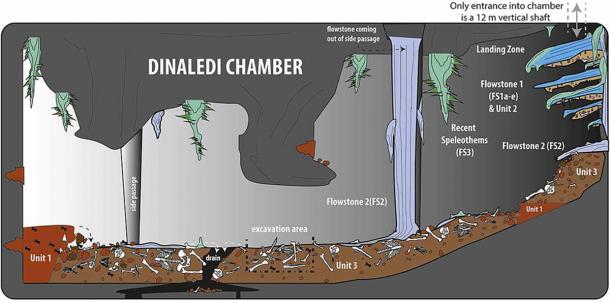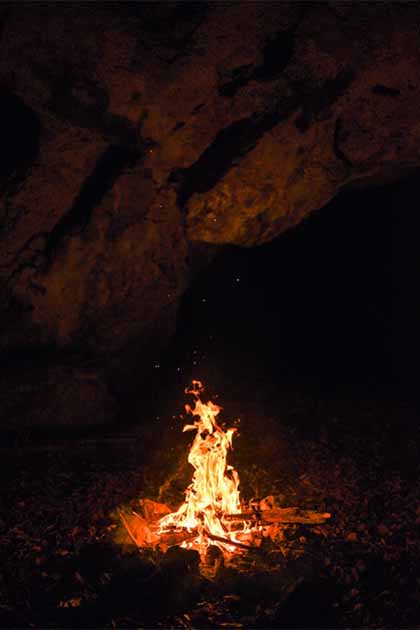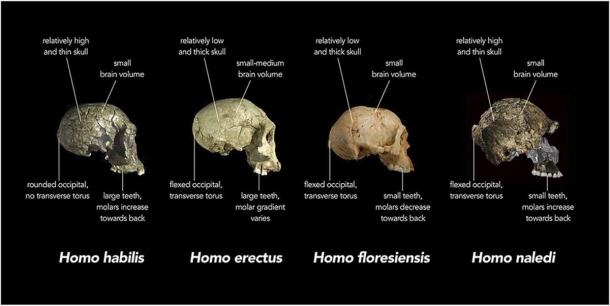
Shocking Evidence Homo Naledi Used Fire 230,000 Years Ago
Ground-breaking new evidence has emerged from South Africa that suggests that Homo sapiens may not have been the first species to use controlled fire. Fossil remains of Homo naledi were discovered in the Dinaledi Chamber of the Rising Star Cave System in 2013. The same underground chamber has now been found to have housed controlled fires, thought to be lit and fed by the ancient hominins.
The finds were announced by paleoanthropologist Lee Berger of the University of Witwatersrand, Johannesburg, in a lecture hosted by the Carnegie Institution of Science in Washington, D.C.. Berger was quoted as saying that “signs of fire use are everywhere in this cave system” created by the species that lived between 200,000 and 300,000 years ago.
- New Stash of Mysterious Homo Naledi Bones Shows They Coexisted with Homo Sapiens
- 11 Mysterious Human Species That Most People Don’t Know Existed
It was Berger and his team who were the first to discover this species in 2013, reported BBC’s Science Focus magazine. “We are fairly confident to formulate the hypothesis that this small-brained hominid, Homo naledi, that existed at the same time we believe Homo sapiens were sharing parts of Africa, was using fire for a variety of purposes,” he added when discussing the discovery made in South Africa.

Illustration of the Dinaledi Chamber, where evidence was found proving that Homo naledi used controlled fire. (Paul H. G. M. Dirks et. al. / CC BY 4.0)
Homo Naledi and Charcoal Fueled Mementos
Homo naledi had a brain that was a third the size of modern humans, but the evidence suggests they had developed an understanding of controlled fire. Their presence in the evolutionary ladder roughly corresponds with the archaeological record for the origination of Homo sapiens. Between their discovery in November 2013 and March 2014, 1550 specimens from 15 different individuals were recovered. Additionally, 133 other specimens were discovered in the nearby chamber of another three individuals.
It was only in August 2022 that Berger entered the “narrow” and “claustrophobic” Dinaledi chamber for the first time. The first thing he noticed was that it was impossible for anyone to navigate these underground spaces without light – the researchers themselves used intense headlamps to virtually crawl through 250 meters (820 ft) of passages, 30 to 40 meters (100 to 130 ft) below the ground. In these pitch-black caves, researchers found remnants of small fireplaces, and sooty wall and ceiling smudges throughout the cave system.

Representational image of controlled fires used within the cave system by Homo naledi. (Kozioł Kamila / Adobe Stock)
That’s when it struck Berger, who looked up and saw the roof of the cave blackened. “As I looked up and stared at the roof, I began to realize that the roof was not a pure calcium carbonate,” he said. “The roof above my head was greyed above fresh flowstone. There were blackened areas across the wall. There were soot particles across the whole of the surface. The entire roof of the chamber where we have spent the last seven years working is burnt and blackened,” highlighted Berger.
In addition, fragments of charcoal, burned antelope bones and rocks arranged as hearths were also added to the fray, reported The Washington Post. Berger described this, rather poetically, as a “serendipitous miracle of palaeontology,” adding to the information obtained by Dr. Keneiloe Molopyane. Her team had discovered a tiny hearth and burnt antelope bones in the other cave known as the Drakensburg chamber.
Berger noted that wherever there was a potentially complex juncture, Homo naledi built a fire. All adjacent cave systems to the chamber were for building fires and cooking animals, rather than disposing the dead, which was what was earlier believed to be true. In fact, in the chamber where they believed that the dead were being disposed, fire was built but animals weren’t being cooked, explained Berger.

Comparative visual illustration of Homo habilis, Homo erectus and Homo habilis. (Chris Stringer / CC BY 4.0)
Control of Fire and the “Culture” of Another Species
Throughout the vast study of evolutionary history, control of fire is one of the most important milestones in human evolution. It provided light to illuminate dark places, enabled activity at night, and inadvertently kept wild animals away. It also made possible the switch from eating raw food to cooking food, allowing the brain to concentrate its energy and expand upon the number of skills that could be adapted or learnt. It is a critical technology in the story of human evolution.
This led Berger and his team to suggest that what they were potentially looking at in this cave-system was the culture of another species altogether. Case in point – Berger had to shed 55 pounds (24.9 kilograms) to just maneuver through these spaces. With the brain of this species being just bigger than a “little orange” it has upset the traditional notion that evolution was a linear ascending ladder that allowed larger brained species to thrive, while the lesser brained ones perished.

A reconstruction of the skull of Leti (Homo naledi) in the hand of Professor Lee Berger. (University of Witwatersrand)
“As I stared at this remarkable coincidence of simultaneous discovery, it made me think about the other spaces,” said Berger. “We clearly had been missing things. This is the most extraordinary period of exploration and discovery, and it’s going to continue,” he concluded. “The next generation don’t have a fear of exploration. Technology is opening spaces and places none of us could’ve have ever thought.”
- New Study On Early Human Fire Acquisition Settles Debate
- Ancient Cave Dwellers Managed Fire to Reduce Smoke Exposure
The team now plan to work on radiocarbon dating their finds to firm up the link between the hearths and the Homo naledi fossils. Breaking convention, Berger reported the discoveries in a press release and lecture, instead of peer-reviewed journals, with a series of major discoveries coming out over the next month that promise to be very exciting! He verified the same on his Twitter feed.
Top image: Researchers have found evidence in South Africa that Homo naledi used controlled fire within caves. Insert: Homo naledi facial reconstruction. Source: Brilliant Eye / Adobe Stock, Insert; Cicero Moraes (Arc-Team) et alii, CC BY 4.0
By Sahir Pandey
References
Bower, B. 2022. “Homo naledi may have lit fires in underground caves at least 236,000 years ago” in Science News. Available at: https://www.sciencenews.org/article/homo-naledi-fire-hominid-cave-human-evolution
Goodyer, J. 2022. “Like modern humans, Homo Naledi harnessed fire for light, warmth and cooking” BBC Science Focus. Available at: https://www.sciencefocus.com/news/like-modern-humans-homo-naledi-harnessed-fire-for-light-warmth-and-cooking/
Johnson, M. 2022. “Ancient human relative used fire, surprising discoveries suggest” in The Washington Post. Available at: https://www.washingtonpost.com/science/2022/12/05/homo-naledi-fire-evolution/
Monama, T. 2022. “Researchers find evidence that Homo naledi used fire” in News24. Available at: https://www.news24.com/news24/southafrica/news/researchers-find-evidence-that-homo-naledi-used-fire-20221204
















Comments
"...Homo sapiens may not have been the first species to use controlled fire."
I would have thought that was a dead certainty.
Adding the zero back to Plato’s timeline puts the demise of the Atlantean culture at the same time of the start of the Ice Age (circa 115 BC). Plato’s description of Atlantis (Richat Structure) suggests, like they say of Rome, it was not built in a day. This should have us consider the time it would have taken the Atlanteans to construct their island of concentric rings within that estuary, quarrying, cutting and stacking all the red and whites stones (local to that area) that were used. From nothing to Atlantis might have taken 100k years or more. So maybe the Smithsonian photo depiction of Homo Naledi is a bit misleading – https://humanorigins.si.edu/evidence/human-fossils/species/homo-naledi
One day, somebody will clone the DNA, a loving surrogate will bear the child, and we’ll know the truth.
Nobody gets paid to tell the truth.